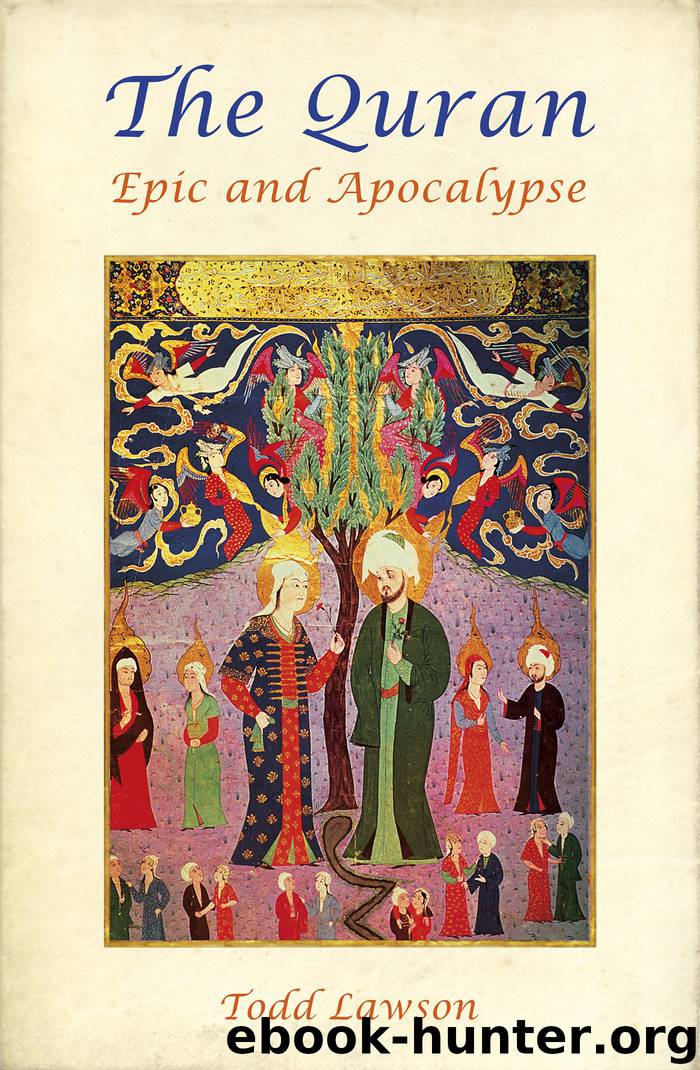The Quran, Epic and Apocalypse by Lawson Todd;

Author:Lawson, Todd; [Lawson, Todd]
Language: eng
Format: epub
Publisher: Oneworld Publications
Published: 2017-10-01T04:00:00+00:00
Chapter 6
Chaotic Cosmos and the Symmetry of Truth
Symmetry, in any narrative, always means that historical content is being subordinated to mythical demands of design and form.
Northrop Frye, The Great Code1
The somewhat playful title of this chapter alludes first to the long tradition of seeing the Quran, at least upon first encounter, as a disordered ‘chaotic’ collection of intermittent, random or casually arranged pericopes, which have been put in some kind of ‘order’ by the early generations of redactors and editors as a scripture for the Islamic religion and Muslims. Research over the past few years, however, has clearly demonstrated that the present form of the Quran represents a number of interconnected logics of structure, content, performance, imagery, textual grammar, vocabulary and poetics.2 Thus, while from the ‘outside’ the Quran appears to lack those essential features of ‘the book’, namely a beginning, middle and end, recent scholarship has remarked about and elucidated the many ways, some more subtle than others, in which the Quran reveals its textual secret of unity and consistency.3 True, the Quran is not like other books, but despite this, in reading the Quran one is never in doubt about its ‘centre of narrative gravity’.4
The second half of the title of this chapter refers to the Sitz im Leben of the Quranic revelation, the conditions of life, the social matrix, the notion, or its absence, of history and the general malaise we are told by sources that seemed to permeate daily life, at least in some quarters: meaninglessness, despair, anarchy and nihilism as these were felt and expressed in the Arabian Peninsula on the eve of the rise of Islam, a mood and ethos frequently denoted by the Arabic word jahl, ignorance, barbarity, injustice (about which more below). However chaotic and brutal this pre-Islamic period was, the Islamic ethos is confident that it was part of a larger scheme, a higher and broader inscrutable sense of order, and that without it Islam as we know it would not have distinguished itself. The juxtaposition of chaos and order is intended to evoke the creative tension that may be seen to have been resolved, or at least addressed, in the Quran and its later interpretation. Here, we are concerned only with the Quran.
However chaos is defined or however it functions, there is no getting away from the fact that one of its main tasks is to affirm and support the terribly human experience of (or ineluctable predilection for), symmetry.5 It is, moreover, clearly no accident, and less an oversight, that not only is there no entry for chaos in the massive Encyclopaedia of the Quran, the word itself seems not to occur more than once anywhere in its nearly four thousand pages.6 While in the Quran and Islam there are a number of ‘chaoses’ (apparently there is no real plural) acknowledged, whether obliquely, by inference, allusion or metaphor, and as such presumed, the familiar one of a pre-creational chaos of emptiness and/or uncontrolled water as the starting point of a cosmogonic process is virtually absent (see a possible exception below).
Download
This site does not store any files on its server. We only index and link to content provided by other sites. Please contact the content providers to delete copyright contents if any and email us, we'll remove relevant links or contents immediately.
The History of Jihad: From Muhammad to ISIS by Spencer Robert(2509)
Nine Parts of Desire by Geraldine Brooks(2284)
The Turkish Psychedelic Explosion by Daniel Spicer(2249)
The First Muslim The Story of Muhammad by Lesley Hazleton(2159)
The Essential Rumi by Coleman Barks(1933)
1453 by Roger Crowley(1882)
The Last Mughal by William Dalrymple(1797)
Trickster Travels: A Sixteenth-Century Muslim Between Worlds by Davis Natalie Zemon(1786)
Muhammad: His Life Based on the Earliest Sources by Martin Lings(1569)
God by Aslan Reza(1565)
by Christianity & Islam(1564)
A Concise History of Sunnis and Shi'is by John McHugo(1518)
Magic and Divination in Early Islam by Emilie Savage-Smith;(1462)
No God But God by Reza Aslan(1438)
The Flight of the Intellectuals by Berman Paul(1402)
Art of Betrayal by Gordon Corera(1368)
Nothing to Envy by Barbara Demick(1330)
What the Qur'an Meant by Garry Wills(1328)
Getting Jesus Right: How Muslims Get Jesus and Islam Wrong by James A Beverley & Craig A Evans(1279)
